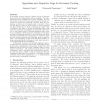Free Online Productivity Tools
i2Speak
i2Symbol
i2OCR
iTex2Img
iWeb2Print
iWeb2Shot
i2Type
iPdf2Split
iPdf2Merge
i2Bopomofo
i2Arabic
i2Style
i2Image
i2PDF
iLatex2Rtf
Sci2ools
SODA
2016
ACM
2016
ACM
Algorithms and Adaptivity Gaps for Stochastic Probing
A stochastic probing problem consists of a set of elements whose values are independent random variables. The algorithm knows the distributions of these variables, but not the actual outcomes. The only way to learn the actual outcomes is to probe these elements. However, there are constraints on which set of elements may be probed. (E.g., we may have to travel in some metric to probe elements but have limited time.) These constraints are called outer constraints. We want to develop an algorithm that picks some set of elements to maximize the (expected) value, subject to the picked subset of elements satisfying some other set of constraints, called the inner constraints. In the past, probing problems were studied for the case when both inner and outer constraints were intersections of matroids; these modeled kidney matching and Bayesian auctions applications. One limitation of past work was their reliance on linear-programming-like techniques, which made going beyond matroid-like struc...
Algorithms | SODA 2016 |
| Added | 09 Apr 2016 |
| Updated | 09 Apr 2016 |
| Type | Journal |
| Year | 2016 |
| Where | SODA |
| Authors | Anupam Gupta, Viswanath Nagarajan, Sahil Singla |
Comments (0)

